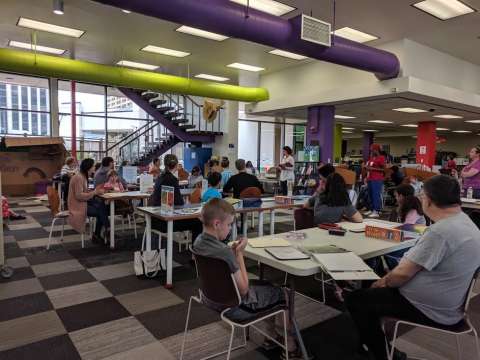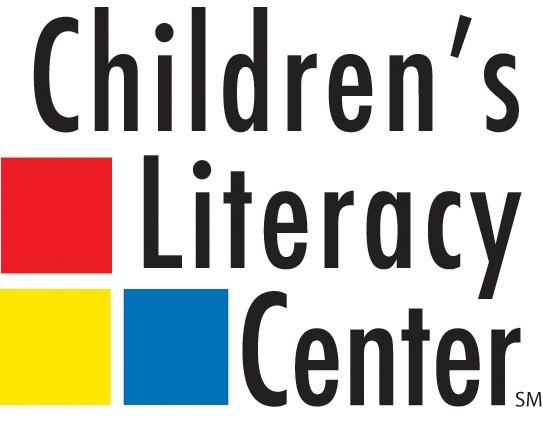
Mike Procell
20 August 2019
Turning A (Non) Profit: How Non-Profits Benefit Our Community’ is an occasional series from 91.5 KRCC. There are thousands of non-profit organizations in El Paso county alone. Some are fairly well known, many are not. 91.5 KRCC would like to introduce you to some of the lesser known organizations, and help you discover some things you may not have known about the more familiar groups. On this occasion we visit with… The Children’s Literacy Center.
A quote from author Neil Gaiman states “the simplest way to make sure we raise literate children is to show them that reading is a pleasurable activity. And that means finding books that kids enjoy, giving them access to those books, and letting them read them.” Neil might have been talking about operations at the Children’s Literacy Center. I can attest to that after my visits to the CLC’s summer tutoring sessions which took place at Penrose Library in downtown Colorado Springs this past June and July.
The Children’s Literacy Center is a homegrown Colorado Springs non profit. It had its humble beginnings as a Junior League of Colorado Springs project in 1991. Since then it has grown considerably. Last year alone, volunteers donated 17,815 hours and provided free tutoring to 569 students. Fifteen locations across southern Colorado currently serve hundreds of elementary school children reading below grade level.
A child is eligible to be enrolled in CLC’s program if they: are reading below grade level; have completed the first semester of first grade; are reading between the first through sixth-grade levels; are not currently on an Individual Education Plan (IEP) or diagnosed with Dyslexia. Home schooled kids are also eligible to apply for tutoring. That process starts with a referral from whatever school district you reside in. If you are interested in enrolling your child in CLC classes you can click here for more information.
I attended the first and final sessions of the summer reading program offered by the CLC at Penrose Library in downtown Colorado Springs. That afforded me the opportunity to talk with a number of parents, tutors, and students, and also guage if any progress had been made in that six week period. I found the atmosphere to be fairly festive on both occasions. Willing tutors, and eager students were seated at tables working hard but also having fun, it seemed. The parents I spoke with mainly wanted their kids to develop more confidence in their reading ability. The kids seemed eager to accept the help being offered. And the tutors were all about sharing their love of reading and engaging these kids to become better readers.
Volunteer tutors are the key to this program. Aside from the physical space needed to accommodate classes, the program is mainly limited by the number of tutors it can recruit. One to one tutoring, the hallmark of CLC, obviously requires one tutor for every student. There is currently a waiting list for students because the demand simply out numbers the supply of tutors. If you would like to become a tutor, click here for more information. The basic requirement is that a tutor needs to be at least 14 years of age. Training is all provided. New training sessions for the fall semester run August 17-28 (2019) with the actual fall tutoring sessions running from September 4 through December 12, 2019.
The need for tutors cannot be overstated, but as for the additional spaces needed to accommodate all this growing and learning, there’s some good news on that front. Two new tutoring sites have been added in the Pikes Peak region – the Silver Key Connections Cafe at 1655 S. Murray and Mitchell High School at 1205 Potter. Also, the La Junta Literacy Project completed its inaugural year. During the 2018-2019 school year, 70 students in 1st, 2nd, and 4th grade received free one-to-one tutoring at the Primary and Intermediate Schools. The second year of the program kicks off September 9th and runs through December 5th, 2019. More information on the La Junta Literacy Project can be found here. And in one of those ‘coming full circle’ stories, a new school in the Banning Lewis Ranch area has as its principal someone who was a CLC tutor when he attended Palmer high school some years ago. Now he’s agreed to host a new CLC tutoring site this fall.
Approximately 27 percent of third grade students in Colorado fail to meet state reading standards. This translates to thousands of children being at risk of failing in school. Children’s Literacy Center works with the community, schools, and families, providing a cost-effective literacy program that shrinks the gap between success and failure.
The Children’s Literacy Center can boast a 95% success rate. “That’s not to say every child is now reading at their grade level”, says Gina Solazzi, the Executive Director at CLC for the past 18 years. She does go on to say, however, that 95% of the kids do show improvement in their reading skills as measured from the initial pre- assessment, which is required upon registration for free one to one tutoring, and the post assessment after 12 weeks in the program. Kids are allowed to continue in the program after 12 weeks until they do reach the point where they are reading at their grade level. That’s when they are considered ‘graduates’.
The extent to which a child can read and write proficiently by the end of third grade will set the pace for their future academic achievement and success. Low literacy rates directly correlate to poverty, a lower quality of life, and fewer employment opportunities. The 2017 State of Literacy in Colorado Report from Stand for Children Colorado states that low literacy rates cost the country at least $225 billion each year due to non-productivity, crime, and lost revenue. Students of color and those eligible for free-and-reduced cost lunch perform at a lower level than their peers. Although any child who cannot read is at-risk, CLC targets underperforming communities where the need for no cost, after school tutoring is greatest.
Another shining feather in the cap of CLC is its platinum rating according to GuideStar USA, an information service specializing in reporting on U.S. nonprofit companies. A number of elements are considered in the checklist for nonprofits, most notably efficiency and transparancy. The pride in Gina Solazzi’s voice was evident when she informed me that 92 cents of every dollar contributed to CLC goes right back into the program. And the more transparent an orgnanization is the more people can feel secure in the knowledge that their dontations are being used for the most good in their communities. ‘Transparent’ non profits received 53% more in contributions, and were considered stronger organizations.
Reading is the way kids learn to critically think, it’s the way worlds open up to them
Meanwhile, back at those CLC summer sessions I attended at Penrose library, the parents I spoke with certainly seemed to feel good, and grateful about having an opportunity for their kids to be able to have a bit of a learning bridge between the school years. Crystal Nelson, who had two daughters in attendance at these sessions, and who also works in special education herself, says kids, like everyone these days just have so many things vying for their attention. She offered a couple of suggestions for ways for parents to engage their children in some “real world applications of what they think they don’t need to know”… turning on the subtitles when watching television can help sometimes with the audio – visual aspect of learning words; and let the kids write the shopping list, then read it and cross things off as they also read product labels and packaging. The bottom line is that it does take a village – parents, other family members, teachers, tutors, etc. to all have a part in the engagement of young people in their quest to learn how to read.
I did wonder if learning to read was best approached if a child is reading from an actual book or an electronic device of some sort. Most of the tutors, parents, and staff at CLC were in agreement an actual book is probably better due to the myriad of distractions offered on a tablet or computer. But ultimately the point is just to read, since it’s like most things – the more you do and practice it, the better you’ll get.
And so the final words, at least in this chapter of the CLC story go to Gina Solazzi, Executive Director of the Children’s Literacy Center… “Reading is the way kids learn to critically think; it’s the way worlds open up to them”.
